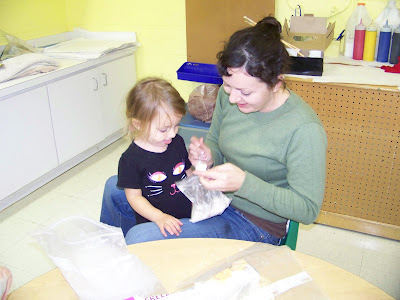
Teaching for Understanding
What is understanding?
How does it develop?
How might we know it when we see it?
What can we do to create learning environments that support and nurture the development of deep understandings?
-From Making Learning Visible p307
Using pictures of children's investigations, actions, and interactions, recording their words... can reveal the genesis of ideas and then in being shared with others, can lead to new thoughts, questions, and discoveries.
-p307

We plan to plant our indoor garden with grass seed. In order, to maximize the meaningfulness of this experience, I wanted to provide the children with an opportunity to explore this new material by itself.
Children can't be expected to understand planting a seed until they've had time to explore the seed itself first.
The children poured seeds, smelled the seeds, some even tasted!, and you can see they used their sense of sight to carefully and closely explore this new material!
J's Mom: What happens when you spray the seeds?
J.: They stick to fingers.
Mom: What happens when we both spray?
J: The seeds get wet!
J: I'm making ice cream. Ice cream is good for you!











Making meaningful connections:
In previous posts, I wrote about our goal of helping children to develop an understanding of how they are similar and different to other animals. That when they begin to see these connections between themselves and others, a deep respect and a sense of wonder emerges within them!
Through observation and recording done by adults we can understand how the child's perspective is effected by observation and interaction with the animal world.
J.'s Mother reported to me that J. was very reluctant to touch the worms in our previous classes. During today's class, she went full circle: from digging them out herself, to spraying them, getting the worms to wiggle, and even holding the worms! Spraying them some more, doing an exctatic "worm dance" and then releasing them back and watching them disappear in the soil.
During class, J's mom recorded J. saying:
"Can I wiggle like a worm?"
(Starts wiggling)
"Can I grab a worm?"
(She hands Mom a stick to do it with her.)
"Can you put it on my hand?"
(Mom does)
J. says: "Hi Worm."
"Worms are dirty, we have to give them a bath."
(Starts spraying).
Mom emailed me after class to report that J. continued her explorations of pretending to be a wiggly worm.
This documentation and communication between teacher and parent tells us that J. is developing a deep understanding of living things and how she is similar to them, the importance of giving children time and multiple opportunities for their investigations.
"Perhaps nothing transforms us or connects us more than becoming another, even for a moment."
Evergreen Community School
http://www.evergreencommunityschool.com/about/documentation.html





Since we were making ice cream with the children today, I thought it would be meaningful for the children to include big blocks of ice in the water table. It seemed like it would connect very nicely (So very teachery of me)! I was anxious to discover what they would say about the ice, or how they would interact with it.
However, once again the children taught me that they make their own connections.
A big block of ice magically appearing in the water table holds NO meaning for them. The children in both classes quickly dismissed it moving it aside in favor of the funnels, seals, or cups.
How could I change their perspective? Perhaps it would create more meaning if they were to choose a container, fill it with water, and put it in the freezer. Then, we retrieve it the following week to "see what happened?"
Of course, this might be difficult with the small amount of freezer space we have available???
It did become clear to me that the children are still deep in the midst of funnel investigations. They did not require anything extra this week in the water table.
So, we will wait a few more weeks before trying additions of ice.








We read the Story, "Not a Box" by Antoinette Portis.
I hoped it would spark the children to "think outside of the box"!
Children are quiet adept at doing so because they don't have preconceived notions of what they are supposed to do.
We encourage that way of thinking by giving them materials and toys that have multiple possibilities. Consider a motorized children's vehicle toy that looks and sounds and drives just like a real vehicle. This type of toy does all the "thinking" for the child. A box can be turned into not only a car, a house, a train, a fort, the options are endless. But... the child has to be able to imagine these possibilities and maybe even possibilities no one has thought of yet!



















































No comments:
Post a Comment